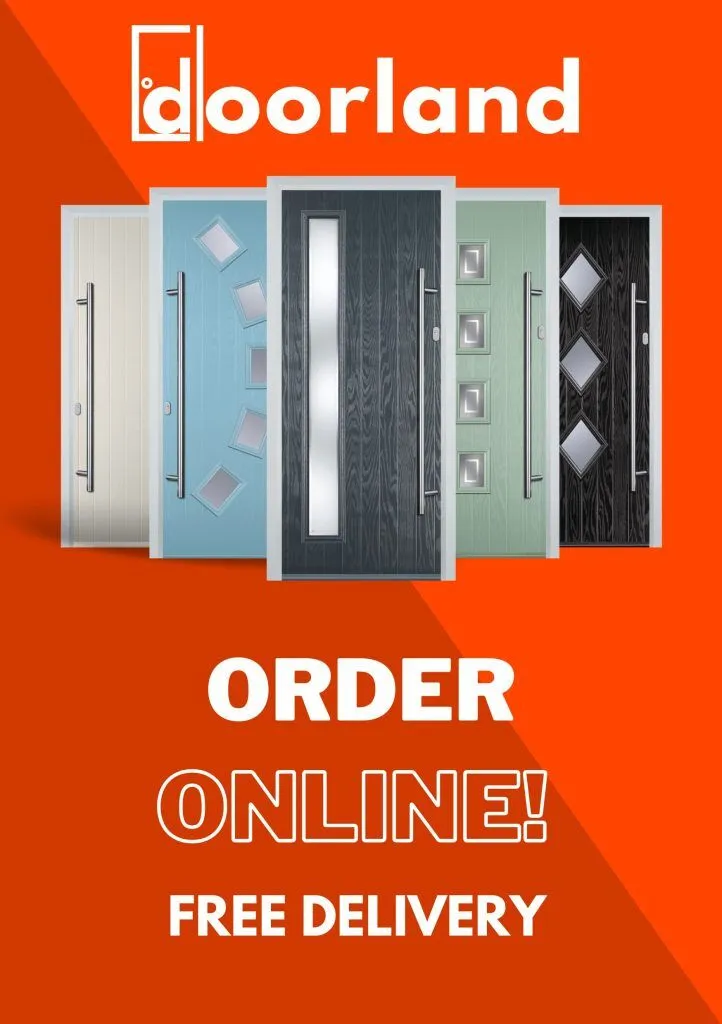The Cost of Replacing External Doors in the UK: External Door Replacement Cost UK
Picture a crisp winter morning, frost gathering on the windowpanes, the scent of freshly brewed tea in the air. You walk to the front door to let the dog out, and a draught brushes past your feet. It’s subtle, but unmistakable. The warmth from your home seeps out as the cold creeps in. That moment, for many UK homeowners, marks the realisation: it’s time to replace the external door.
Whether your concern is heat loss, security, or simply giving your home a refreshed kerb appeal, the cost of replacing an external door in the UK can feel confusing at first. Prices can vary dramatically, one quote mentions a few hundred pounds, another edges into the thousands. But what truly drives these costs? And how do you know what’s right for your home?
At Doorland, we’ve supplied thousands of homeowners, tradespeople, and developers across the UK with composite doors, uPVC doors, and uPVC back doors that balance price, performance, and personality. Every project tells a story from a century-old terrace being restored to its former charm, to a modern home owner upgrading for energy efficiency and style.
In this article, we’ll explore the key factors affecting the external door replacement cost in the UK, breaking down what influences price, where savings can be made, and how to make sure your next door is an investment that lasts. Because replacing an external door isn’t just about cost, it’s about comfort, security, and long-term peace of mind.
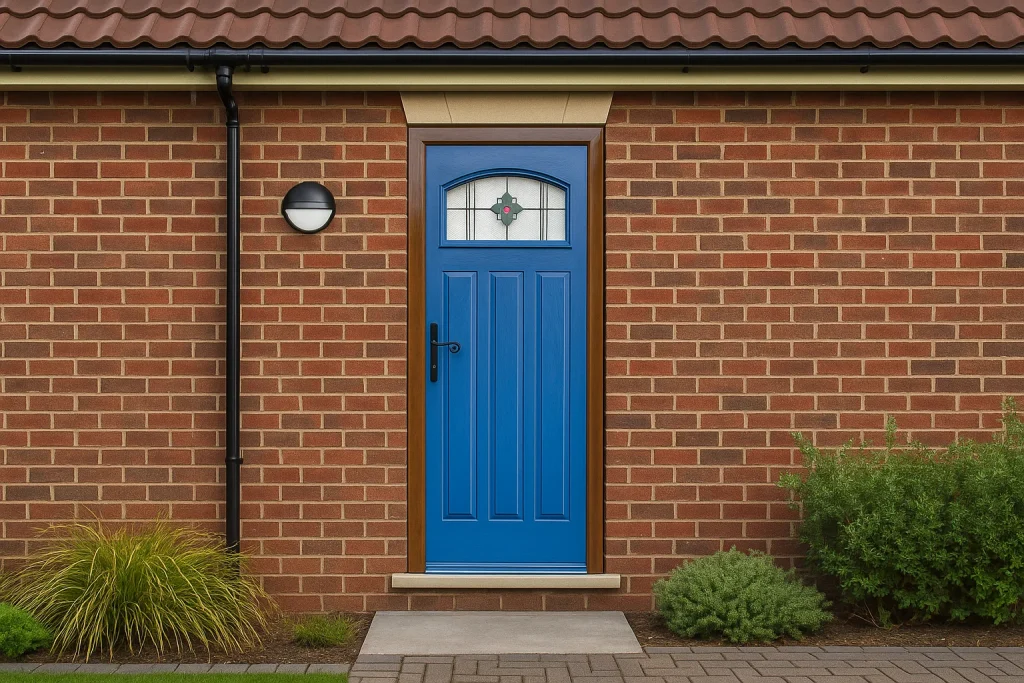
What Affects the Cost of Replacing an External Door?
Think of your front door as a personal handshake, it’s the first impression every guest receives and the silent guardian between your family and the world outside. Naturally, replacing it comes with choices that influence both cost and quality.
Material Matters
The biggest factor in determining the external door replacement cost in the UK is the material. Each option offers a balance of style, insulation, and durability:
- uPVC Doors – A cost-effective, low-maintenance choice, ideal for busy households. Expect to pay between £580 and £1380 for supply and installation. Perfect for back or side doors, uPVC doors resist warping, peeling, and fading over time.
- Composite Doors – The premium upgrade. Built from layers of timber, uPVC, and reinforced materials, composite doors combine strength, insulation, and aesthetic appeal. Prices usually range from £900 to £2,700, depending on glazing, hardware, and colour options.
- Timber or Hardwood Doors – Traditional and elegant, but with higher maintenance and cost. Expect prices from £1,200 upwards depending on wood type and finish.
Installation and Fitting
A professional installation ensures your door fits securely and performs as expected. Labour typically adds £200–£400 to the total cost, especially if adjustments are needed to the frame or threshold. At Doorland, our experienced tradespeople measure, fit, and seal every door with precision, no shortcuts, no compromises.
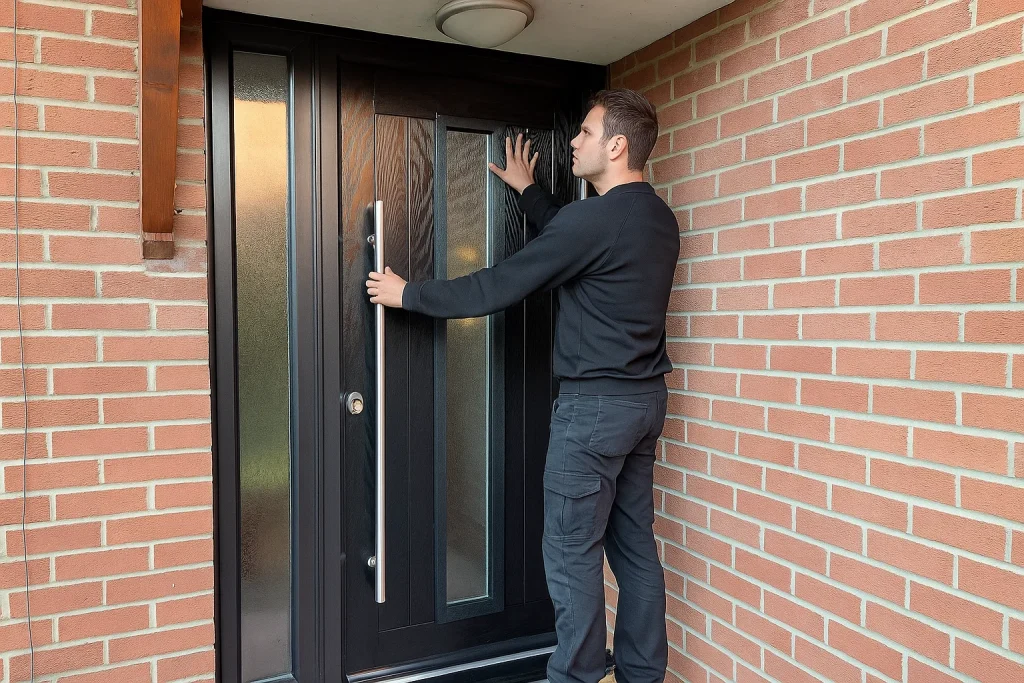
Additional Features and Finishing Touches
Modern doors can include multi-point locking systems, A+ rated insulation, and toughened glass for added security and energy efficiency. These features might raise the upfront cost slightly, but they help reduce energy bills and boost long-term performance. Like adding thermal lining to a winter coat, you don’t see it every day, but you’ll certainly feel the difference when the cold sets in.
Average Door Replacement Costs by Type and Location in the UK
For most homeowners, the real question isn’t just how much does a door cost, but what should I expect to pay for my specific situation? It’s a fair question after all, not every home, installer, or location in the UK carries the same costs. Replacing an external door is a bit like ordering a custom suit. The basic pattern might be the same, but the fit, fabric, and finishing details are what determine the final price. Let’s explore how the average external door replacement cost in the UK breaks down depending on the type of door and where you live.
Average Door Replacement Costs by Door Type
According to data from Checkatrade and MyBuilder (2024), the average cost to replace an external door in the UK ranges from £800 to £2,500, depending on the material and features. Here’s a closer look:
| Door Type | Average Supply & Fit Cost (UK) | Typical Use | Maintenance Level |
| uPVC Front Door | £550 – £1850 | Front or back entrance | Very low |
| Composite Front Door | £900 – £1,900 | Front entrance | Very low |
| Hardwood / Timber Door | £1,200 – £2,500 | Premium traditional homes | Moderate to high |
| Aluminium Door | £1,200 – £1,800 | Modern builds and extensions | Low |
| uPVC Back Door | £600 – £1550 | Rear or side access | Very low |
Source: Checkatrade UK Door Installation Costs 2024, MyBuilder Price Guide
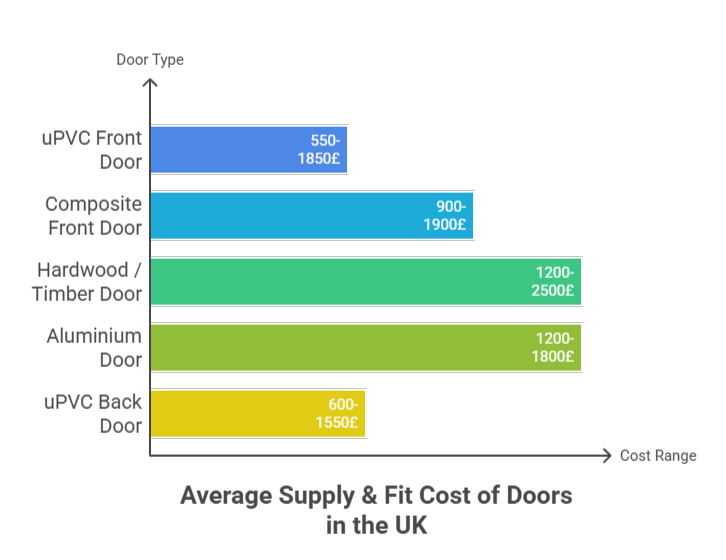
If you’re replacing an older uPVC back door with something more modern and thermally efficient, you’ll likely find excellent value in Doorland’s uPVC back door range. These doors combine affordability with modern styling and A-rated insulation, ideal for energy-conscious homeowners. Similarly, composite doors remain the top choice for those seeking both beauty and strength. While they may cost a little more initially, their lifespan and minimal maintenance make them one of the most cost-effective long-term upgrades available.
Regional Variations in Door Replacement Costs
Just as property prices vary across the UK, so too can the cost of replacing external doors. Labour rates, access challenges, and local material suppliers all influence final quotes. Here’s what you might expect regionally:
- London and South East: Typically 10–20% higher than the national average due to higher labour and transport costs. Composite door replacements here can reach £1,600–£1,800.
- Midlands and North of England: Closer to national averages, with uPVC door replacements from £650–£1700 and composite doors from £900–£1,600.
- Scotland, Wales & Northern Ireland: Prices are often slightly lower overall, though remote locations may see extra travel costs.
A homeowner in Manchester recently told us how switching from a tired timber door to a composite one transformed not only their home’s look but its comfort level. “It’s made the hallway warmer, quieter, and just feels so much more secure,” they shared a perfect example of why the right door is more than a cosmetic upgrade.
At Doorland, we advise customers across all UK regions, helping them choose doors that suit their budget and local environment. Whether you’re fitting your own door or working with a professional installer, we can help you measure up with confidence and order online, no pressure, no hidden costs.
How to Budget for an External Door Replacement (and Avoid Hidden Costs)
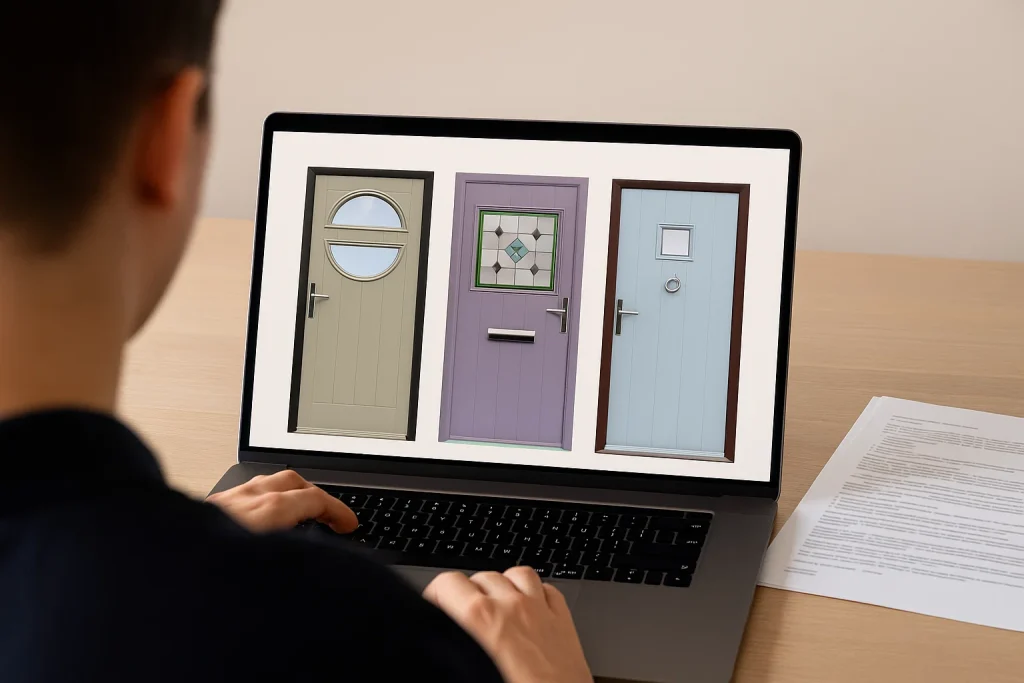
Replacing your external door is more than paying for a new slab of wood, uPVC or composite, it’s an investment in comfort, security and long-term performance. It’s like planning a road trip: you don’t just budget for fuel, you factor in tolls, snacks, detours… and maybe a stop for ice cream. If you overlook the small extras, your project budget can quietly drift off course. At Doorland we’ve walked thousands of customers through this journey from first quote to final fitting so we know that the “hidden costs” often aren’t hidden at all, just unanticipated. Our tradespeople bring real-world experience, and this section uncovers the traps and helps you plan for them.
Step 1 – Itemise Supply, Installation and Finishing Costs
Start by breaking down your budget across three major components:
- Supply: The door material (uPVC, composite, timber) + any frame, glazing, hardware. For example: when you opt for one of our high-security multi-point lock composite doors you’re paying for materials built to last and for the certification that confirms it.
- Installation: Labour, labour travel, removal of old door, any adjustments to the opening, waste disposal. Our fitters at Doorland emphasise that a door is only as good as its installation “no shortcuts, no compromises.”
- Finishing touches & extras: This is where “hidden” costs often sneak in. Think upgrading to A+ energy-rated glass, decorative or bespoke colours, side panels, letterboxes, smart locks, or even a new threshold for better weather sealing.
By clearly listing these three buckets and getting quotes for each, you’ll build a realistic budget rather than relying on a single “door cost” figure.
Step 2 – Ask Smart Questions and Check Inclusions
Experience tells us that quotes vary in what they include. Ask your supplier or installer:
- “Is the frame included or is it supply only?” If the frame isn’t replaced and is warped or worn, you may face extra costs later.
- “Are finishings (handles, letterbox, threshold) included or extra?” Many basic quotes omit these, which causes surprises.
- “Does the quote cover removal of the old door and disposal?” Efficient tradespeople will handle this as part of a seamless job.
- “What lock standard and glazing spec do I get?” A door that includes a multi‐point locking system and toughened or double-glazed glass may cost a bit more up front but will protect you better in the long run.
By asking these questions you position yourself as an informed homeowner (or trade professional). That boosts trust and avoids those “oh, didn’t think of that” costs.
Step 3, Contingency and Regional Budget Adjustments
Even the best-planned project can have surprises. A small contingency of ~10% of your total quote is wise. Here are typical adjustments we see across the UK:
- Region & labour rates: Labour rates in London/South East tend to be higher. According to a cost-guide source, composite door replacements in the South East can reach ~20% above the national average. Internal Doors+1
- Frame condition or structural adjustments: If your old frame is damaged, rotten or out-of-square, you may need additional building work (lintel, new reveal, brickwork).
- Extras you may opt for later: Most customers upgrade once they see the full range, e.g., adding glazed side lights or smart access systems.
Step 4, Long-Term Value and Running Costs
When budgeting, keep your eye not only on the upfront cost but on the value over time. A door is like planting a tree: the best time was years ago, the next best time is now. Here’s what to consider:
- Energy efficiency: A poorly-fitting or low-rated door lets the warmth escape, increasing heating bills. By choosing a door with good insulation and a quality fit, you may recoup cost via lower bills.
- Maintenance and lifespan: A cheap door today that warps, draughts or locks fail will cost more in the long run. Our composite door range at Doorland offers minimal maintenance and long lifespan.
- Security and insurance: A high-quality door with certified locks may reduce risk and possibly lower home insurance premiums.
Kerb appeal and resale: First impressions matter. A premium front door replaced by you or your installer can add value to your property—not just financially, but in perception.
Choosing the Right Door Material for Your Budget and Lifestyle
Choosing an external door is a bit like finding the right pair of shoes, it needs to look the part, fit perfectly, and last through all seasons. For UK homeowners, that means balancing cost, durability, energy efficiency, and style. Whether you’re replacing a front door to enhance kerb appeal or upgrading your back door for better insulation, the material you select plays the starring role in both performance and price. At Doorland, we’ve spent years helping customers make confident choices. From modern composite doors to classic uPVC styles, each material tells its own story. Choosing the right one depends on how you live, where you live, and what you value most.
Composite Doors, Premium Look, Lasting Value
A composite door is like the all-weather jacket of the home, stylish enough for everyday use, tough enough for anything the British weather throws at it. Made from layers of timber, uPVC, and reinforced materials, composite doors combine the warmth of wood with the resilience of modern engineering.
Typical composite door replacement costs in the UK sit between £900 and £1,500, depending on style, colour, glazing, and hardware options. While that’s a higher upfront investment than uPVC, the long-term savings in maintenance and heating make them outstanding value. Every composite door supplied by Doorland includes:
- Multi-point locking systems tested to the latest security standards
- A+ rated insulation for lower energy bills
- Toughened safety glass options for extra protection
- Custom colours and glazing designs to match any home style
A recent customer from Birmingham told us: “Our new composite door transformed the look of our home — and we instantly noticed fewer draughts. It’s not just a door; it’s peace of mind.”

uPVC Doors – Affordable, Durable, and Low Maintenance
For those who want a reliable, budget-friendly option, uPVC doors are a proven favourite. They offer exceptional weather resistance, minimal upkeep, and clean, contemporary designs — perfect for both front and uPVC back doors. A typical uPVC external door replacement cost in the UK ranges from £450 to £850, including installation. That affordability makes them ideal for landlords, DIY renovators, or homeowners upgrading multiple doors. Benefits of uPVC doors include:
- Excellent value without compromising on security
- Low maintenance just a wipe with a damp cloth to stay looking fresh
- Resistant to warping and fading even after years of British weather
- Energy-efficient options with reinforced cores
uPVC may not have the bespoke finish of composite, but for everyday performance and budget-conscious projects, it’s hard to beat.
Timber and Aluminium, Character and Modern Minimalism
If you love character, timber doors bring a timeless elegance to period homes. They’re warm, tactile, and beautiful, but they do need regular care. Expect to budget from £1,200 upwards for a well-made hardwood or engineered timber door. For sleek modern properties or extensions, aluminium doors are growing in popularity. With slim frames and clean lines, they offer a striking architectural look with durability to match. Expect to pay around £1,200–£1,800 for supply and installation.
Matching Your Door to Your Lifestyle
When choosing between materials, consider how you live:
- Busy family home: A composite or uPVC door offers peace of mind and minimal maintenance.
- Period property: A timber or wood-effect composite maintains the heritage look while improving insulation.
- Modern new build: Aluminium or high-gloss composite doors complement contemporary architecture.
- Rental or multi-property owner: uPVC doors deliver reliable, low-cost consistency across several homes.
Every home tells a different story, and at Doorland, our goal is to help yours start with the right door.
When to Replace Your External Door (and Signs It’s Time)
Sometimes, the decision to replace your door isn’t driven by style or budget, it’s necessity. Much like a pair of shoes that’s lost its sole, an old door eventually stops performing as it should. But how do you know when that moment has arrived? Over the years, Doorland’s tradespeople have seen every sign imaginable, from stiff hinges to daylight peeking through the frame. Below, we’ve outlined the most common warning signs that it’s time to replace your external door, along with practical advice for homeowners across the UK.
1. Draughts and Temperature Changes
If your hallway feels noticeably colder than the rest of your home, your door could be the culprit. Worn seals, warped frames, or outdated materials allow warm air to escape, something most UK homes can’t afford given rising energy costs. In fact, the Energy Saving Trust estimates that draught-proofing doors and windows can save households up to £60 per year on heating bills (source: Energy Saving Trust). Modern composite doors and uPVC doors are designed with A+ rated thermal efficiency, eliminating cold spots and helping maintain consistent indoor comfort.
2. Difficulty Opening, Closing, or Locking
Over time, doors can expand, contract, or shift slightly in their frames. A little stiffness is normal, but if you’re forcing the handle or lifting the door to lock it, that’s a red flag. A door that doesn’t sit flush isn’t just inconvenient, it compromises security. Our installation experts often explain it like this: “If you have to wrestle with your door, your door’s no longer working for you.” Upgrading to a composite door or uPVC model ensures a smooth, secure fit, thanks to reinforced hinges, weatherproof seals, and precision engineering.
3. Visible Damage or Deterioration
Peeling paint, cracked panels, or water damage are all signs that your door’s protective layers have worn thin. Once moisture seeps in, it can lead to swelling, rot, or rust depending on the material. A homeowner in Leeds recently shared with us how replacing their weathered timber door with a uPVC back door instantly brightened their kitchen and stopped recurring damp issues around the threshold. A small aesthetic upgrade quickly became a functional improvement, making their home warmer, dryer, and more secure.
4. Outdated Security Features
If your door still relies on a single lock or basic latch, it’s time to consider a security upgrade. Today’s composite and uPVC doors come with multi-point locking systems tested to PAS 24 standards, offering superior resistance to forced entry. At Doorland, every door we supply is built with both strength and style in mind because a secure home shouldn’t come at the expense of design.
5. Faded Finish or Poor Curb Appeal
A door contributes up to 40% of a home’s kerb appeal, according to property styling experts (source: House Beautiful UK). If your front door’s colour has faded, the glass has fogged, or the frame looks tired, replacing it is one of the simplest ways to refresh your property’s exterior. A bold composite front door in a modern shade can transform your home’s appearance and first impression.
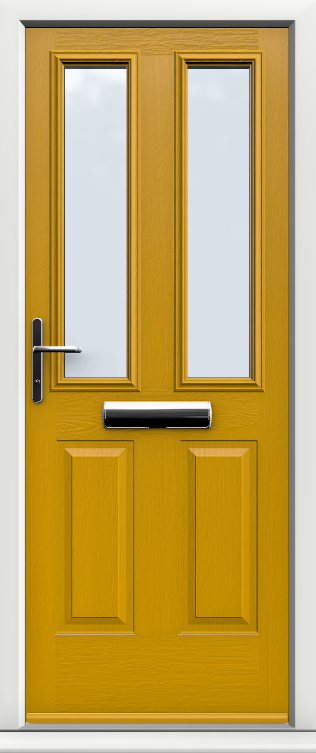
Professional vs DIY Door Replacement – Which is Right for You?
When it comes to replacing your external door, the choice often comes down to two options: hire a professional or do it yourself. Each approach has its appeal. One offers peace of mind, the other offers potential savings. But as our experienced Doorland installers often say, “the right decision depends on your skill, your tools, and your tolerance for risk.” Replacing a door might seem straightforward, but getting it right requires precision. A few millimetres out of alignment can affect insulation, security, and even how easily your door opens and closes. Let’s explore both options so you can make a confident, informed choice.
Professional Door Installation – Confidence Built In
For most homeowners, professional installation is the best route. It ensures that your new composite door or uPVC door is correctly fitted, sealed, and finished to the highest standard.
Advantages of Professional Fitting
- Precision and expertise: Professionals have the right tools, training, and experience to measure and fit doors perfectly, especially important for composite and double-glazed models.
- Regulation compliance: Installers follow current UK Building Regulations (Part L for energy efficiency and Part Q for security), ensuring your door meets all standards.
- Warranty protection: Many manufacturers require professional fitting for warranties to remain valid.
- Time and safety: Replacing a heavy door can be physically demanding and risky without proper equipment.
Our customers often tell us how much reassurance they feel knowing their new door was installed by skilled tradespeople. One homeowner from Bristol described it best: “The fitters were brilliant, in and out within a few hours, no mess, perfect finish. Worth every penny.” At Doorland, our professional network ensures every installation is handled by experienced fitters who treat your home with care and precision.

DIY Door Replacement – When It Makes Sense
For confident DIYers or trade professionals, a supply-only option can offer flexibility and cost savings. Doorland’s supply-only service supports both independent fitters and homeowners who prefer to handle their own installation.
When DIY Can Work Well
- You have previous experience fitting doors or windows.
- You own the correct tools (level, wedges, drill, sealant gun, expanding foam).
- The existing frame is in good condition and doesn’t require structural adjustment.
- You’re replacing a like-for-like uPVC or composite model where measurements are already accurate.
Potential Drawbacks
- Mistakes can be costly, an ill-fitted door may leak, jam, or void warranties.
- You’ll need to handle disposal of the old door and any frame debris.
- Finishing details like thresholds and trims can take longer than expected.
For peace of mind, many customers choose a middle ground: ordering supply-only doors from Doorland, then hiring a trusted local tradesperson for fitting. That way, you enjoy both flexibility and professional assurance.
Cost Comparison – Professional vs DIY
| Option | Typical Cost (Including Door) | Pros | Cons |
| Professional Installation | £900 – £2,500 (composite) / £450 – £850 (uPVC) | Guaranteed fit, warranty, building regulation compliance | Higher upfront cost |
| DIY Supply-Only | £600 – £1,900 (composite) / £350 – £650 (uPVC) | Lower cost, flexible timing | Risk of misfit, no installation warranty |
The difference in cost is usually around £200–£400, but the peace of mind that comes with professional fitting is often well worth it — especially when dealing with secure front or back doors.
Maximising Your Door Investment – Maintenance and Longevity
A well-chosen door should serve you faithfully for decades, not just years. Whether you’ve opted for a composite door, a uPVC back door, or a traditional timber design, proper care and maintenance can make all the difference in extending its lifespan and keeping your home looking its best. Think of your door like a car: even the most reliable model performs best with a little routine care.

Regular Cleaning and Inspection
Dust, pollution, and rain can gradually dull the finish of any door.
- uPVC and composite doors: simply wipe with a damp cloth and mild soapy water every few months. Avoid harsh chemicals or abrasive pads that can damage the surface.
- Timber doors: inspect annually for cracks or peeling paint. Re-coat or varnish every few years to maintain the seal and prevent moisture damage.
During cleaning, check hinges, handles, and locks. A quick squirt of silicone spray keeps moving parts smooth and corrosion-free. Tip from our installers: “A clean, well-sealed door not only looks better, it keeps the warmth in and the weather out.”
Maintaining Security Features
Even premium hardware needs occasional attention. Test locks and handles regularly to ensure smooth operation and no looseness. If you feel resistance or misalignment, it might be time for adjustment; a simple fix that prevents long-term wear. Modern multi-point locking systems on composite and uPVC doors offer exceptional security, but their strength depends on correct alignment and maintenance. Keeping these locks lubricated and free of grit ensures effortless function and lasting protection.
Protecting Against the Elements
In the UK’s unpredictable weather, external doors face everything from winter frost to summer UV exposure.
- Composite doors are built to resist warping, swelling, and fading.
- uPVC doors offer excellent moisture resistance and won’t peel or flake.
- Timber doors may need more regular sealing or painting to handle humidity changes.
If your home is exposed to strong sunlight, a light-coloured or UV-resistant finish will minimise fading. Doorland’s range includes UV-stable coatings designed specifically for long-lasting colour and protection.
Longevity Expectations by Door Type
| Door Material | Typical Lifespan (Years) | Maintenance Level | Comments |
| Composite | 25–35 | Low | Exceptional durability and insulation |
| uPVC | 20–30 | Very low | Resistant to weather and colour fade |
| Timber | 15–25 | Moderate to high | Requires repainting or re-sealing |
| Aluminium | 30–40 | Low | Long life with minimal upkeep |
A well-maintained door not only lasts longer but continues to perform as intended, keeping your home secure, efficient, and stylish for years to come.
When Maintenance Turns Into Replacement
Even the best-cared-for door reaches the end of its life. When repairs become frequent or energy bills rise due to poor insulation, it’s often more cost-effective to invest in a replacement. Upgrading to a new composite or uPVC door from Doorland ensures you benefit from modern materials, improved energy efficiency, and enhanced kerb appeal, all with professional advice every step of the way.
External Door Replacement Cost UK Frequently Asked Questions..
What is the average cost of replacing external doors in the UK
The cost of replacing external doors in the UK typically ranges from £550 to £2,500 depending on the door material and fitting. A uPVC back door is usually between £450 and £1850 including installation, while a composite front door often falls between £900 and £3,200 due to its premium design and insulation quality.
Why does the cost of replacing external doors in the UK vary so much
The cost of replacing external doors in the UK depends on several factors including material, door size, security features, glazing, and regional labour rates. Composite and timber doors cost more because they provide higher strength and better insulation compared to standard uPVC doors.
Is professional fitting worth it when considering the cost of replacing external doors in the UK
Yes. While professional installation may add £200 to £400 to the total cost, it ensures a perfect fit, maintains your warranty, and guarantees compliance with UK building regulations. Poor DIY fitting can lead to draughts or misalignment, increasing long-term costs.
What type of external door lasts the longest in UK weather
Composite doors usually last between 25 and 35 years with minimal maintenance. They resist warping, swelling, and fading far better than timber. uPVC doors also offer great longevity, often lasting over 20 years when cleaned and maintained regularly.
How can I reduce the overall cost of replacing external doors in the UK
To lower the cost of replacing external doors in the UK, choose supply-only options if you have access to a reliable fitter, compare quotes regionally, and opt for energy-efficient uPVC doors for secondary entrances. These strategies can save hundreds without sacrificing quality.
What are the signs that it is time to replace an external door
Common signs include visible damage, draughts, difficulty locking or closing, or rising heating bills due to poor insulation. When you notice these issues, replacing the door with a modern composite or uPVC model will improve comfort, security, and appearance.
Are uPVC doors still a good choice for UK homes
Absolutely. uPVC doors remain one of the best value options in the UK thanks to their low maintenance, excellent insulation, and affordability. They are ideal for both front and back doors and can be customised in different colours and styles.
Does the cost of replacing external doors in the UK include removing the old door
Most professional installers include removal and disposal in their quote, but it is always worth confirming before booking. Some DIY or supply-only services may charge a small extra fee for old door removal.
How can I ensure my new external door is energy efficient
Look for A+ rated or double-glazed doors with insulated cores. Both composite and uPVC options from Doorland are designed to minimise heat loss and keep your home comfortable year-round, reducing energy bills.
Who can I trust for accurate advice on the cost of replacing external doors in the UK
Doorland has years of experience supplying composite and uPVC doors across the UK. Our professional team can advise on the right style, material, and installation method to suit your budget while ensuring lasting security and performance.


